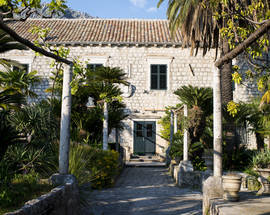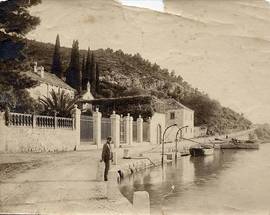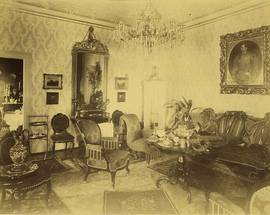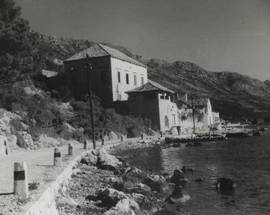One of the things that most visitors to Dubrovnik learn sooner or later is that the former city-state was a republic of nobles in which most power resided in a tightly-knit group of aristocratic families. But where did these aristocratic families live? Where are their palaces?
The Old Town is full of narrow streets and tall, space-challenged houses, leaving very little visual evidence of the city’s aristocratic past. Although there is plenty of fine architecture within the city walls, especially when it comes to the former city-states’ governmental buildings (the Sponza Palace, for example, or Knežev dvor), family homes tend to be hidden behind plain stone facades – private grandeur was rarely put on public display.However an aristocratic villa culture did exist outside the city walls, where Renaissance houses with walled gardens are still a prominent feature of the Dubrovnik landscape. Some of these villas remain in private hands, some are owned by institutions, and quite a few languish uninhabited, the potential targets of some ultra-expensive future renovation project. Very few indeed are accessible to the public, rendering Dubrovnik’s villa culture an enduringly secretive, semi-hidden world.
The one villa that appears in all the guidebooks is the Gučetić villa at Trsteno, 13km up the coast, where the Croatian Academy of Science’s Arboretum draws busloads of visitors. It’s an undeniably lovely place and is well worth visiting for a multitude of reasons, but neither house nor garden has preserved its original appearance.
The museum of the Renaissance villa is, it seems, the one obligatory Dubrovnik heritage attraction that is still waiting to be invented.
Indeed this villa culture is just as important to the city’s heritage as its medieval walls or its monastery cloisters. It was in the fourteenth century that Dubrovnik’s wealthier families first started building second homes outside the city walls. The number of these increased enormously in the sixteenth century, when it became the standard aspiration of noble families – and the wealthier non-noble families – to have a place outside the city.
It’s difficult to agree on a general English name for these villas – literal translations of the Croatian terms ljetnikovac (summer house) or ladanjska kuća (country house) don’t quite convey how important these residences were to the life of the city. They were used all year round, and very often became the centre of a family’s social life rather than a place of quiet retreat. These second homes were rarely showy or palatial – outward extravagance was considered bad form among Dubrovnik nobles – but they did offer both the luxury of space, and access to the outdoors. They were frequently located near to the family’s fruit orchards, vineyards and olive groves, so had an economic role as well as a purely relaxational one.
There were certain conventions governing the shape of these villas. They usually took an L-shaped form, with a main building comprising central hall surrounded by four rooms, and an annex leading down the a waterfront boat house. Within the villa’s walls would be a garden divided up into box-hedge quadrants, with pergolas to enable shaded strolling, and possibly a fishpond connected by a small channel to the seafront outside.
The sixteenth-century explosion of second homes led to changes in lifestyle and culture. It was at these villas that people would meet to talk about the latest developments in business affairs or the arts, or attend parties at which music or plays would be performed. The villas themselves were frequently decorated with artworks and surrounded by gardens, which only served to enhance their cultural symbolism. Indeed it would not be unfair to say that Dubrovnik’s cultural and scientific life took place in the villas outside the walls rather than inside the city itself.
According to leading expert on villa architecture Nada Grujić, the whole experience of the Renaissance in this part of Croatia was shaped by the villa lifestyle. “Thanks to these villas a particular form of socializing occurs, in mutual conversations and debates”, she wrote in 1991. “In reading and discussing art a specific way of thinking was formed, along with our Renaissance literature, philosophy and culture.” It is impossible to imagine that Renaissance noble Nikola Gučetić could have written his dialogues On Beauty and On Love (1581) anywhere else than at his villa at Trsteno, where the philosophical conversations described in his texts probably took place.
Given the many violent ruptures in Dubrovnik’s history (notably the earthquake of 1667, or the destruction wrought by the Franco-Russian War of 1807), it’s perhaps surprising that so many of the city’s Renaissance villas have survived. Few of the original villa-owning families are still around. Many of Dubrovnik’s aristocratic houses fell on hard times in the nineteenth century and were forced to sell up their historic properties – frequently to returning economic migrants who had made their fortune in South America. Another watershed occurred after 1945, when many of the big houses were nationalized and shared out among public institutions.
Dubrovnik’s Renaissance villas are still an important feature of the landscape, although they are often hidden behind high walls and palm trees, or edged into anonymity by neighbouring modern buildings. Several villas line the waterfront of Gruž harbour, with yet more to be found along the shores of the Rijeka Dubrovačka - the sea inlet spanned by the Franjo Tuđman suspension bridge just to the west of Gruž.
None of these villas are currently open to the public on a walk-in basis, although tours taking in several prominent houses can be arranged through local tourist agencies. One of the villas you will be taken to is the Sorkočević villa on the southern side of Gruž harbour, which now belongs to the Dubrovnik Historical Institute. Surrounded by a high crenellated wall, the villa looks a bit like a castle – although it belongs to an era when Dubrovnik’s borders were expanding and there was no longer any real fear of sea-borne invaders. It was built in 1521 by Petar Sorkočević, who served four times as rector of the city, and whose family had grown rich on the proceeds of the Balkan silver-mining trade. Inside is a small museum collection relating to the history of Dubrovnik and a lovely old library. The villa’s chapel contains a 15th-century statue of Dubrovnik’s patron St Blaise, carved by prolific Dalmatian stonemason Juraj Dalmatinac, architect of the UNESCO-listed Šibenik Cathedral.
One other villa that regularly opens its doors to organized tours is the Bunić-Kaboga Villa, located at the southeastern end of the Rijeka Dubrovačka. Recently restore to its Gothic-Renaissance glory by descendants of the original family, this colonnaded mansion is frequently used as a venue for conferences and social events. The Villa Stay, next door to the Bunić-Kaboga house, has been home to the Dubrovnik Restoration Institute since 1998, and will also open its doors to visitors on a pre-arranged tour.
One place that anyone can stop off at is the Sorkočević villa, now serving as the administrative building of the ACI Marina at the Rijeka Dubrovačka’s northern end. Although you can’t visit the interior of the villa, it’s an undoubtedly beautiful spot, with the bobbing boats of the marina overlooked by a ring of stony hills. The villa’s garden, with its geometric box-hedge layout, is a popular venue for wedding photographs, and if you come here on a Saturday you’re almost certain to see a bride and groom posing beneath the pergola.
Carry on around the curve of the Rijeka Dubrovačka inlet and you will come to Mokošica, where modern tower blocks dwarf a handful of ruined villas, including the Gucetić Villa, famous for its arcaded Gothic-Renaissance façade. Although restoration work is still in its early stages, the villa has been earmarked as the future site of the Mokošica Cultural Centre – a welcome sign that Dubrovnik’s once great villa culture has not yet breathed its last.
To find out more about tours of Dubrovnik’s Renaissance summer houses contact the Dubrovnik tourist office, or drop a line to registered tour guide Branka Franičević (brankaf@du.t-com.hr) who will be glad to offer a tailor-made tour.
Jonathan Bousfield










Comments